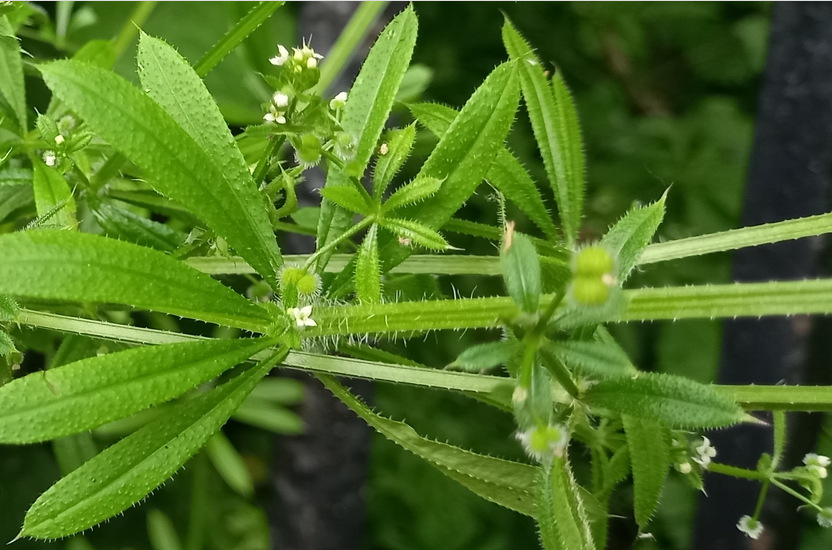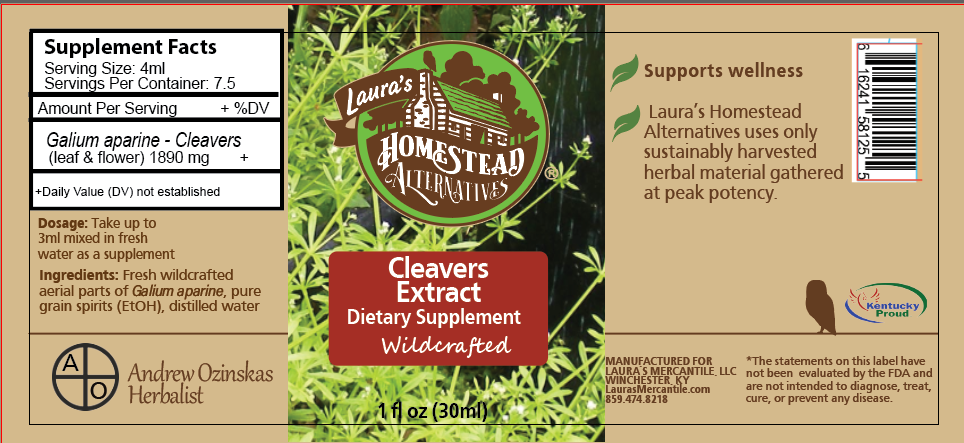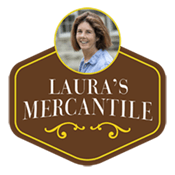Cleavers aka Galium aparine, or Lady’s Bedstraw if you’re from a couple centuries ago, refers to a helpful wild medicine plant that grows all over the Northern Hemisphere. It’s widespread, so it’s likely you’ve encountered it. You may have even wondered what is the deal with its unusual growing habit. From one skinny speck of a root, cleavers can clamber and crawl over the top of yards of yard or meadow. It has a clinging fuzzy exterior to its vining stems which carries on into its little bur of a seed. Some folks dry the seed and use it as part of an herbal coffee substitute (I haven’t tried this, though I use chickory, dock and burdock, sometimes with coffee too, for a nice warm bitter drink). The main way people use it medicinally is to make a tea of the leaves, stem and flowers– ideally before it makes its little burs.

Medicinal Uses of Cleavers, aka Galium aparine
As the old Farmer’s Almanac simply describes for us, “Cleavers is cooling diuretic, meaning it moves water and lymph out of the body through the urinary tract. The cooling property of cleavers also helps to soothe inflammation that can come with swollen or stuck lymph in the body. Because the lymphatic system is so closely connected to the immune system, taking cleavers can also help move things along when experiencing sickness.”
The Practical Herbalist, similarly describes its usefulness in “clearing out baggage” that our bodies might be packing around after dealing with a season of colds or allergies, and also its diuretic action which can be helpful at clearing out UTIs. Practical Herbalist author, Candace Hunter also references Cleavers’ usefulness for “healing in the nervous system, especially when spasm, convulsion, or injury are present.”
“Cleavers has strong affinities to the lymphatics, kidneys, and nervous system. It assists in the penetration and breakup of fibrous tissue and calcifications in the body for which it is known. Cleavers has the ability to work calcifications, concretions, and fibrosities out of the tissues (muscles, lymph, kidneys). It has been used for the removal of gravel and suppression of urine. Herbs that remove urinary stones also usually remove calcifications in the system.
“Cleavers is primarily used for lymphatic congestion and in lymphatic conditions where there is evidence of mild warmth and inflammation. It also acts on the breasts. It is indicated in breast tissue that is generally fibrous, rather than tissue with scattered cysts or nodularities.
“Cleavers is a ‘deer medicine’, a category in Native American herbalism associated with the nerves. It is beneficial in ‘gatherings of the nerves’ and inflammation of the nerve endings (neurofibrositis). It is indicated for oversensitivity of the nerve endings, tickling and itchy skin. It is a specific in Dupuytren’s contracture and Morton’s neuroma, when the tendons tighten up under the middle fingers or toes.
Excerpted from The Earthwise Herbal: a complete guide to Old World medicinal plants by Matthew Wood
Whole plant, wide-angle thinking about our herb medicine friends
In the quote above we get a glimpse into herbalist Matthew Wood’s strategies for identifying useful medicines for his clients, looking for confluences and agreements among evidence that is empirical (it works), biomedical (we can trial it), intuitive (it makes sense) and traditional (it has been used this way historically). As he wrote in his dissertation:
“By embracing different methods of perceiving and interacting with the natural world herbalism makes itself more professionally holistic – it can accept different people and different methods of human intelligence, both in practitioners and in clientele. The use of ‘participatory’ methods also brings herbalism into a closer relationship with the plant, encouraging a more holistic experience of medicinal agents. Rather than viewing medicinal plants as bags of chemical constituents to be broken up and reductionistically studied, herbalists may retain a view of them as whole beings, valuable in their wholeness. The author suggests that more study could be made of the differences between the use of constituent parts and the whole herb.”
Matthew Wood: An Exploration of the Conceptual Foundations of Western Herbalism and Biomedicine, 2006
On this note, we would like to offer our Cleavers tincture.

Like all of our high quality herbal extracts, we use wild-grown (scrappy-tough means more potent medicine!) whole plants, responsibly harvested at peak potency. Cleavers is also included in our “Spring Cleaning” formula. If you aren’t able to process your own medicine, try our tinctures today.




